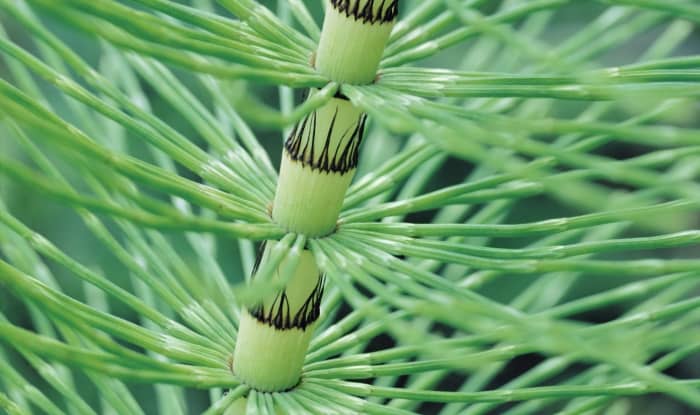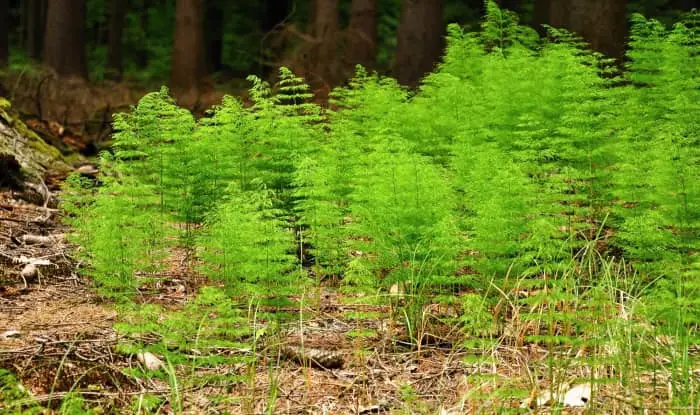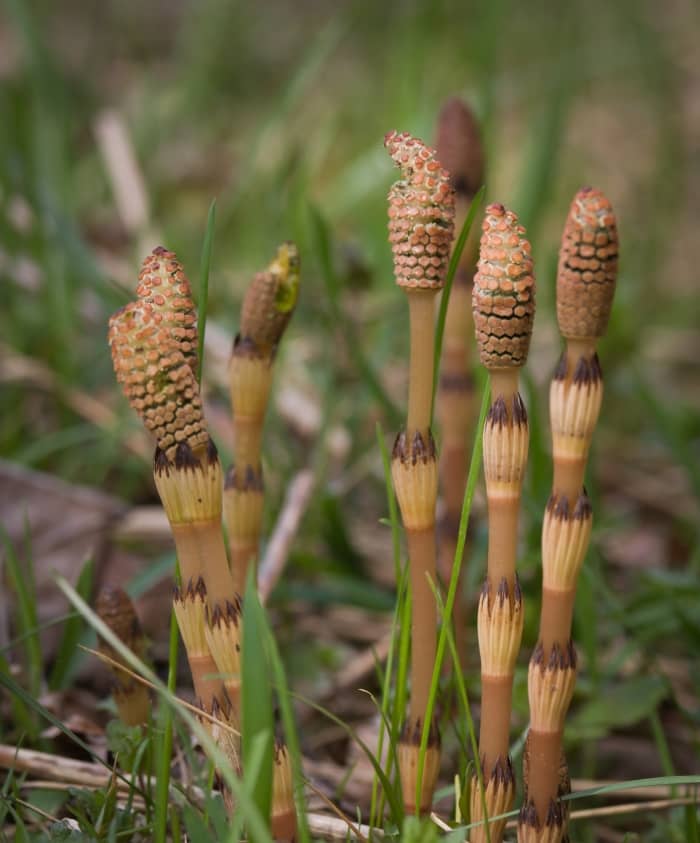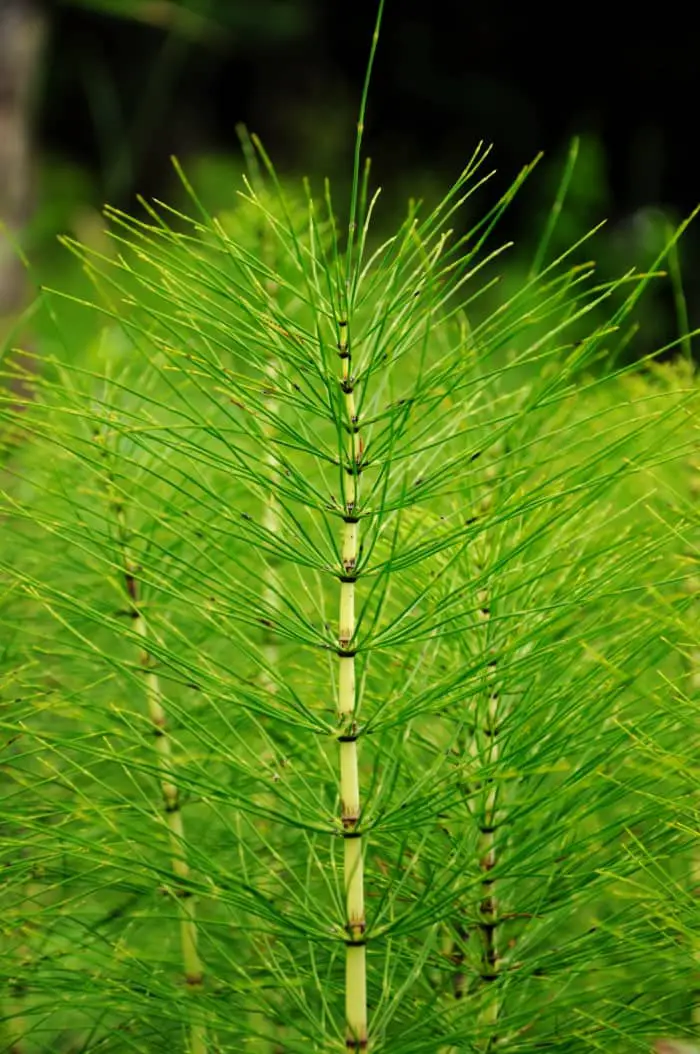Few weeds strike more fear into a gardener than horsetail.
This primitive perennial weed has been around since the dinosaurs. And it’s perfectly adapted for survival.
It has a deep and extensive root system. Along with the ability to spread through spores and rhizomes. Making it difficult to eradicate once established.
But fortunately, there are some effective methods you can use.
Let’s take a look at how to kill horsetail weed.
8 ways To Kill Horsetail Weeds
Chemical Weed Killer
Horsetail (Equisetum arvense) has a hard waxy cuticle that makes it difficult to kill with herbicides. But if you use them in the right way it’s possible to control the plant.
Choosing the right product is crucial. To get the best results you should use a post-emergent systemic weed killer. This kills the horsetail from the inside all the way down to the root.
Weed killers containing glyphosate can do the job, such as RoundUp. But a better choice are products containing the herbicides 2,4-D and triclopyr. So the best weed killer for horsetail is Crossbow.
Southern Ag Crossbow Specialty Herbicide On Amazon
To use weed killer effectively, you first need to cut the weeds back or crush the stems and leaves. Then spray or paint the weed killer on to the damaged areas so it can get inside the plant.
This approach is very effective at killing horsetail above the ground, and you’ll notice results after your first application. But it may take a number of tries before you kill the plant roots as well, preventing it from regrowing.
Make sure you dispose of any parts you cut away carefully. Burn them or allow them to rot in a bin liner. Don’t dispose of them in landfill, by dumping them in the countryside, or by adding them to your compost pile.
Using A Pre-Emergent Herbicide
A good way to control the growth of horsetail is to use the pre-emergent herbicide Casoron. It won’t kill the horsetail plants that are already growing. But it will prevent the growth of new shoots.
Use Vinegar As A Natural Weed Killer
Vinegar is good at killing horsetail above the ground. But the normal table variety isn’t strong enough to do the job. Instead, you need to get high-strength vinegar with an acetic acid concentration of around 20-30%.
Similar to chemical weedkiller, your results will be better if you first damage the plant by cutting the stems or crushing the leaves.
Vinegar is a contact weed killer. This means it can destroy the parts of the plant it touches. But it won’t kill the roots. So the horsetail will re-grow.
However, destroying the growth above ground with repeated applications can weaken the plant. And if applied regularly over a long enough period it can cause it to die.
As useful as it is, using vinegar has a drawback:
The problem is that it’s non-selective. So it will kill any plants it comes into contact with. Making it difficult to spray on grass lawns or around desirable plants.
Change The Soil Conditions

Change the soil conditions away from the ones it prefers to something more suitable for the healthy growth of desirable plants.
Improve Drainage
Fill in any depressed and boggy areas that are holding water. And make sure that heavy rain drains easily from the area.
If the drainage problems are severe enough this may involve laying a drainpipe or digging a perimeter ditch to siphon away the water.
Apply Dolomite Lime
Add the lime to the soil as per the instructions on the packet. This increases the pH of the soil away from the acidic conditions that horsetail prefers.
But horsetail can still grow in alkaline conditions, so this won’t be enough on its own.
Add Fertilizer
Wait 2 weeks after adding the lime before you add fertilizer to the soil. Mixing in some compost can also help to prepare the soil for your plants to grow.
Although changing the soil conditions will encourage horsetail to disappear naturally, don’t expect it to happen over night. You need to give it a year to see the improvements.
And you might still find the occasional horsetail plant growing. So be prepared for a long process that can take 5 years or more to completely eradicate the weed.
Prevent It From Getting Light
Like other plants, horsetail uses the process of photosynthesis to create energy for it’s growth and spread. To do this, it needs access to sunlight.
If you can prevent it from seeing the sun you can control it and eventually cause it to die off.
One way to do this is to cover it in black tarp. This is practical for a small area. But it might not be possible if you have a large area to control.
Cover the area and pin the black tarp down. Then leave it for at least two years to exhaust the plant.
12 months usually isn’t enough to kill horsetail weed. And when you remove the tarp the plant will start to regrow.
A drawback of this weed control method is that it’s only practical in areas where you don’t mind killing all the plants and starting again.
It’s very difficult to use if the horsetail is growing in the middle of your garden with plants you want to keep.
Another way of preventing the plant from photosynthesising is to keep cutting it down at the stem whenever it starts to grow. This weakens the plant over time, eventually causing it to die
But it does take a lot of work. And you need to constantly look out for the new shoots as they grow. And it still takes a couple of years to completely get rid of the horsetail.
An alternative option for denying the plant light is to plant taller plants alongside it. Thick shrubs, big perennials, and tall ferns, are all useful.
Horsetaill thrives in full sun. And it also grows in partial shade. But it doesn’t like deep shade and will weaken over time. It may take two or three years, but eventually it will disappear.
Dig And Sift
If you’re happy to start from scratch in the infested area you can try to kill horsetail weed by digging and sifting.
This is another method that’s most suitable for localized infestations. But it’s not as practical over large areas.
It involves digging up all the horsetail weeds that you find, trying to remove the roots and rhizomes at the same time.
Next remove the soil to a depth of around 1 foot. Put it through a soil sifter with approximately ¼ inch holes in the mesh and take out any leftover bits of rhizomes. Then place the soil back in the area.
Horsetail has a deep root system, so tubers that remain will occasionally sprout. But if you keep an eye out for new plants you can get rid of them before they have a chance to produce rhizomes.
Killing Horsetail With Fire
Killing horsetail with fire can be an effective method. But similar to cutting the plant down, it requires a commitment to the process over some time.
Using a propane weed torch you can burn and kill the part of the plant that’s above ground.
It won’t stop it from regrowing. So you need to do it whenever you see new shoots appear. Over a few years, you can weaken the plant sufficiently to kill it off.
Control Returning Spores
Even after you kill horsetail weed in your yard you still need to be vigilant. Eradicating horsetail is usually a multi-year job.
You’ll notice the leafless shoots of fertile horsetail plants appear in April. The domes on top contain spores that spread the weed.
It’s best not to walk through a patch of these stems in case you carry the spores with you to new areas. Instead, cut off the domes before they ripen. Then place them in a bag for careful disposal.
Things To Avoid When Killing Horsetail Weeds
Horsetail is a difficult weed to control. And some methods will make the problem worse.
You should avoid cultivating the soil to get rid of horsetail. It won’t work.
Instead, you’ll spread bits of chopped up rhizome through the soil. Each part can produce a new plant, increasing the spread and giving you even more work to do.
If you do decide to cultivate the soil, make sure to clean your tools after to make sure there aren’t any bits of rhizome left on the blades. Otherwise you may end up spreading the plant to another part of your garden.
Killing Horsetail With Salt
Adding enough salt to your soil will create inhospitable conditions for horsetail to grow. You can mix it with water and pour it over the infested area.
But this isn’t a recommended way of dealing with the problem.
Why? Two reasons:
Firstly, although salt will kill horsetail it will probably leach into nearby areas of your garden, killing the plants there as well.
And secondly, because it makes the soil unsuitable for any plants to grow. And this can last for a long time. Preventing you from replanting the area.
Killing Horsetail With Bleach
You can kill horsetail with bleach. It damages the plant. And it raises the pH of the soil to levels that make it difiicult for anything to grow.
But some of the problems of using it are similar to salt.
Soaking an area of your garden with bleach will prevent you from growing desirable plants in the area for a long time after. And the bleach will leach into nearby areas.
Killing Horsetail With WD40
Surprisingly for many, you can actually kill horsetail with WD40.
But you have to be very careful where you spray it, as it’s a pollutant. You don’t want it getting in your soil.
Using a weed killer is more practical.
Horsetail Identification
This perennial weed produces two different types of stems:
The infertile stems are thin and tall. With joints along the stem that produce several spreading branches.
The fertile stems are short and thick. And they usually have a white or brown color. With a green-brown cone on top that contains the spores for reproduction.
As the name suggests, it has a similar appearance to a horses tail. But some people also think it resembles a bottle brush.
Is it Horsetail or Marestail?
The confusion seems to lie in the similar names of these two weeds. With many people blaming marestail for an invasion of horsetail in their garden.
But there are key differences between horsetail and marestail that make it easier for you.
Firstly, horsetail doesn’t flower. Whereas marestail is a flowering annual weed.
And secondly, marestail is an aquatic weed. You’ll usually find it in ponds, streams, and bog land. But it can sometimes invade poorly drained areas of your garden.




This is a cursed weed and a nightmare to control it has the power to come straight through a thick tarp type membrane would you believe.
This weed has taken over my entire back yard. I have spent entire summers trying to dig it up – doing down as far as 4 feet. I have used lime to increase the pH. I have used black tarps. It spread like wildfire after i used compost & mulch on the entire yard. I have even tried the crush & paint on roundup method (i’m very leery of chemicals since i grow organic food (organic edible landscaping).
Nothing had worked.
I need suggestions & help beyond this list. I’m tired of my neighbours fighting with me because it’s spreading under the fence into their yards 🙁
Thank you!
Lisa, I’m sorry you’re at odds with your neighbors over this. Perhaps explaining that you DID NOT PLANT IT, will help them gain perspective that it’s not ‘coming from your yard’.
Sorry you’re having to deal with it. We have it too, hence this reply.
You’re offorts have been heroic! I don’t like using poisons either, but it sounds like cutting it & applying Sledgehammer to the cut stem will kill it & the rhizomes. Crossbow is another product. A neighbor applied Crossbow with an eye dropper. Sounds like it takes 2 years of this method.
Thank you so much for the product referrals. Unfortunately, i can’t find either of those in Canada 🙁
I’ll keep looking!
I have horsehair in my flower bed. I have no idea how I got it and I have tried roundup full strength which does nothing, I cut it back and it just keep on growing. I just sprayed what was out in the open part of the bed with 45% vinegar. But now that I have read what you recommend it might have been a waste of time. Where does this come from?
Nancy
I was told the horsetail in the gardens of the home we bought a few years ago came from mulch purchase from a local farm.
I to am plagued by this dratted weed, I now just cut the shoots off as they appear, by pushing a sharp knife into the soil as low as I can and slice off the stem. I have been doing this for along time and they are much less of a problem than they used to be. Good luck.